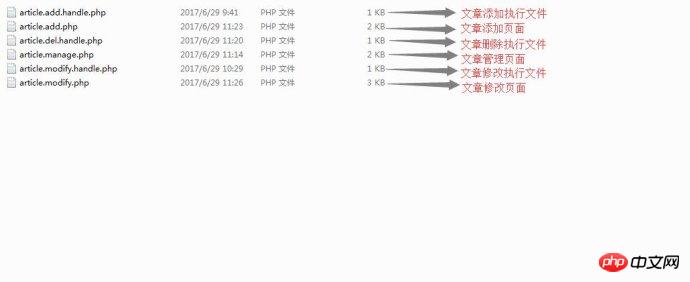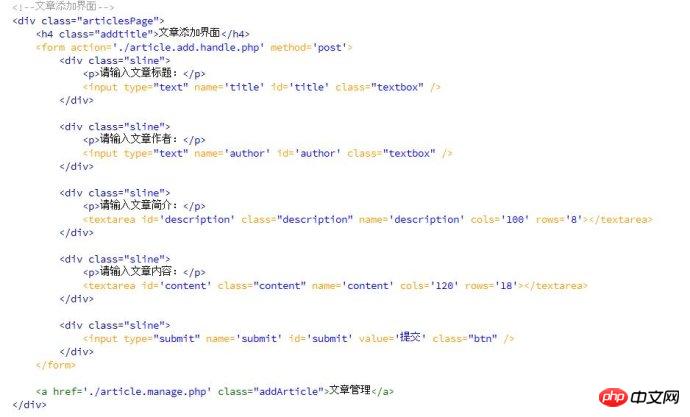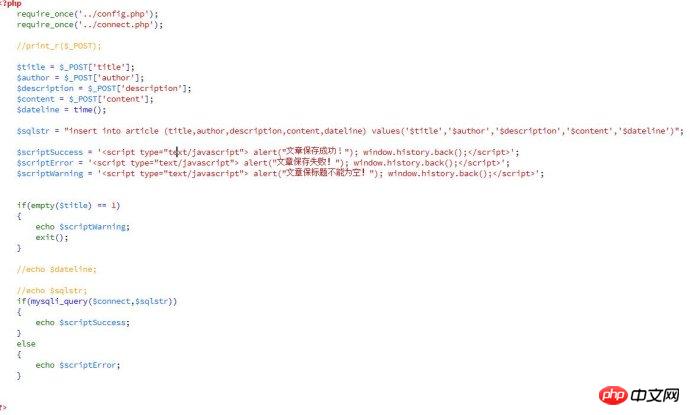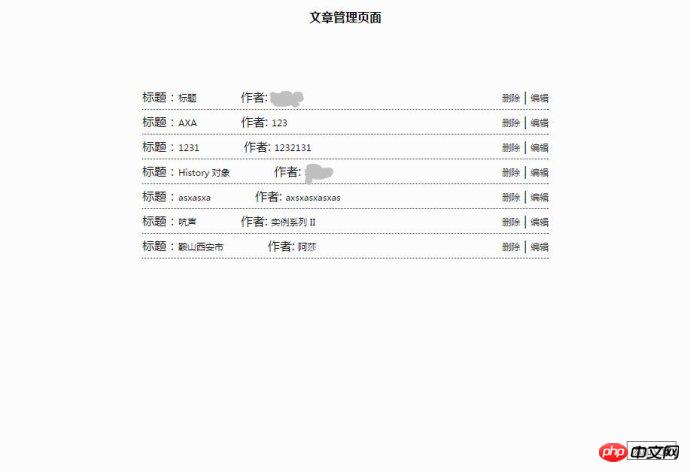
Dieser Artikel teilt Ihnen hauptsächlich die PHP+MySQL-Implementierung der Artikelverwaltung und des Anzeigecodes mit. Ich hoffe, dass er allen helfen kann.
1. Erforderliche Ordner und Dateien erstellen

2. Neu erstellen entsprechende Verwaltungs- und Ausführungsdateien im Ordner admin

3.Konfiguration config.php Inhalt, konfiguriert hauptsächlich die Konstanten im Zusammenhang mit der Datenbankverbindung
defined('DS') or define('DS',DIRECTORY_SEPARATOR); defined('PATH') or define('PATH',dirname(__FILE__)); define('HOST','localhost'); define('USERNAME','root'); define('PASSWORD','root');
4.Konfigurieren Sie die Datenbankverbindungsdatei connect.php, konfigurieren Sie hauptsächlich die Initialisierung im Zusammenhang mit der relevanten Datenbankverbindung
require_once(dirname(__FILE__).DIRECTORY_SEPARATOR.'config.php'); $connect = mysqli_connect(HOST,USERNAME,PASSWORD); mysqli_select_db($connect,'lgc'); mysqli_query($connect,'set names utf8');
5. Konfigurieren Sie den hinzuzufügenden ArtikelHTMLSeite

6.Artikelzusatzverwaltung konfigurieren

7 .Konfigurieren Sie die Artikelbearbeitungsseite. HTML Der Inhalt stimmt mit der Seite zum Hinzufügen von Artikeln überein, nur die Aktion verweist auf Article.modify.handle.php
require_once('../config.php');
require_once('../connect.php');
$id = $_GET['id'];
$modifySqlstr = "select * from article where id = $id";
$arr = array();
if($con = mysqli_query($connect,$modifySqlstr))
{
while($row = mysqli_fetch_assoc($con) )
{
$arr2 = $row;
}
}Der HTML-Inhalt wird hier weggelassen (wobei das der Artikelergänzungsseite HTMl relativ konsistent bleibt)…
8.配置文章编辑页面执行文件
require_once('../config.php');
require_once('../connect.php');
//print_r($_POST);
$id = $_POST['id'];
$title = $_POST['title'];
$author = $_POST['author'];
$description = $_POST['description'];
$content = $_POST['content'];
$dateline = time();
$modifySql = "update article set title='$title', author = '$author', description = '$description', content = '$content' where id = $id";
$scriptSuccess = '
$scriptError = '
if(mysqli_query($connect,$modifySql)){
echo $scriptSuccess;
}else{
echo $scriptError;
}
mysqli_close($connect); 9. 配置文章删除执行文件
require_once('../config.php');
require_once('../connect.php');
$id = $_GET['id'];
$delStr = "delete from article where id = $id";
$scriptSuccess = '
$scriptError = '
if(mysqli_query($connect,$delStr))
{
echo $scriptSuccess;
}else{
echo $scriptError;
}10.配置文章管理页面

执行php代码:
-- 查询获取所有文章信息:
require_once('../config.php');
require_once('../connect.php');
$con = mysqli_query($connect,'select * from article');
$arr = array();
while($row = mysqli_fetch_array($con,MYSQLI_ASSOC) )
{
$arr[] = $row;
}
//print_r($arr);-- 遍历生成文章信息列表:

11.配置文章列表(详情)展示页面:
require_once('./config.php');
require_once('./connect.php');
$id = $_SERVER['QUERY_STRING'];
if(empty($id)){
$sql = 'select * from article order by dateline desc';
}else{
$id = $_GET['id'];$sql = "select * from article where id = $id "; //配置文章详情展示页面
}
$con = mysqli_query($connect,$sql);$arr = array();while($row = mysqli_fetch_array($con,MYSQLI_ASSOC)){ $arr[] = $row;}
//遍历生成文章首页文章列表

12. 总结:
mysqli_query(connection,query,resultmode);
在判断是否插入成功,或者查询成功的时候,不能直接把mysqli_query(参数)当成if语句的条件,在因为针对成功的 SELECT、SHOW、DESCRIBE 或 EXPLAIN 查询,将返回一个mysqli_result 对象,并不是返回一个布尔值;在针对其他的成功的查询,例如update等,则返回布尔值true,失败则返回false;
object(mysqli_result)#2 (5) { ["current_field"]=> int(0) ["field_count"]=> int(6) ["lengths"]=> NULL ["num_rows"]=> int(1) ["type"]=> int(0) } ; 在返回对象的时候 $object = mysqli_query(参数); 然后可以用$object -> num_rows 的值来确定是否匹配查询到内容!
相关推荐:
Das obige ist der detaillierte Inhalt vonPHP + MySQL implementiert die Artikelverwaltung und die gemeinsame Nutzung von Anzeigecode. Für weitere Informationen folgen Sie bitte anderen verwandten Artikeln auf der PHP chinesischen Website!
 So öffnen Sie eine PHP-Datei
So öffnen Sie eine PHP-Datei
 So entfernen Sie die ersten paar Elemente eines Arrays in PHP
So entfernen Sie die ersten paar Elemente eines Arrays in PHP
 Was tun, wenn die PHP-Deserialisierung fehlschlägt?
Was tun, wenn die PHP-Deserialisierung fehlschlägt?
 So verbinden Sie PHP mit der MSSQL-Datenbank
So verbinden Sie PHP mit der MSSQL-Datenbank
 So verbinden Sie PHP mit der MSSQL-Datenbank
So verbinden Sie PHP mit der MSSQL-Datenbank
 So laden Sie HTML hoch
So laden Sie HTML hoch
 So lösen Sie verstümmelte Zeichen in PHP
So lösen Sie verstümmelte Zeichen in PHP
 So öffnen Sie PHP-Dateien auf einem Mobiltelefon
So öffnen Sie PHP-Dateien auf einem Mobiltelefon




